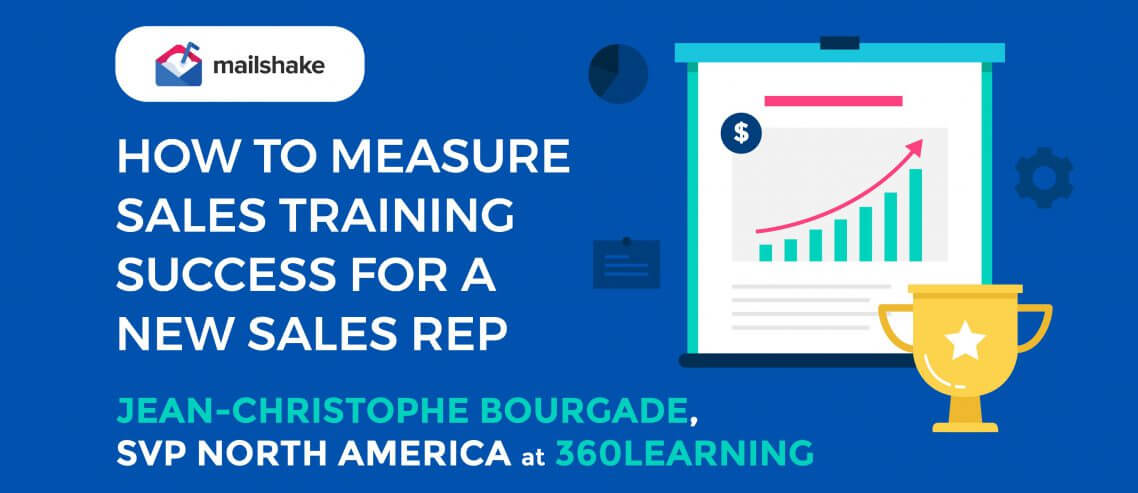How to Measure Sales Training Success for a New Sales Rep

Contents
Training and onboarding schemes for new sales reps can be difficult to get right – but it can be even more challenging to work out how effective they are.
With this in mind, I sat down with Jean-Christophe “JC” Bourgade, Co-Founder of 360Learning, a collaborative learning platform.
JC has been in a sales leadership role from the get go and has onboarded more than 100 reps, AEs, SERs, and account managers, so he knows what he’s talking about when it comes to sales training success.
What Does a Successful Training Program or Onboarding Program Look Like? [1:11]
JC advises that sales leaders make their onboarding program:
- Rep-centric
- Scalable
- Data-driven
Here’s what he means by each point.
Rep-Centric
JC explains that a common pitfall when it comes to traditional sales onboarding is to frontload all the information during the first 15 days of employment – meaning that they’re going to forget a lot of it.
“Whenever you think about onboarding, make sure you provide the learning at the point of need -– when people will apply it,” he recommends.
He also suggests integrating learning into the flow of the sales process.
“Make sure you don’t have to force your reps to choose between learning and selling – why not do both at the same time?” he says. “Embed learning in the tools your reps are living and breathing.”
So how else can sales leaders put reps at the heart of the onboarding process?
-
- Make it role-specific
- Make it bite-sized
- Gamify the experience to ensure that reps know what they’re supposed to achieve every day
- Use roleplay
“Sales is one of those topics that’s like sport,” JC explains. “You might learn the theory forever, but it doesn’t mean that you’ll turn into Steph Curry. So make sure that 60-70% of your onboarding is roleplay intensive.”
2. Scalable [4:26]
JC recommends that leaders automate “as many tasks as possible” to ensure that the process is low touch for managers.
“Make sure that your reps will know what they need to do on day one, day two, day three, six months down the line, by providing clarity of the path and micro-objectives,” he says.
JC is also a big fan of involving as many experts as possible within the onboarding and training process – both internal and external.
“At 360learning, there’s something like 20-30 people involved in upskilling our reps,” he explains. “In product, legal, customer success, and of course in the sales team – top performers and colleagues, so it’s not just senior sales leadership.
“If you do that, you’re making your process a lot more scalable.”
3. Data-Driven [5:32]
“Make sure you create knowledge checks as your reps progress along their journey, and define KPIs and metrics that allow you to measure the success of your training,” JC advises.
What Metrics Should We Track? [5:58]
According to JC, we should start with the basics:
- Quota attainment
- Hit ratio
- Time to first deal ratio
- Deal size
“You want to measure every single training against the impact it has on these KPIs. But you should go way beyond those KPIs, because they only show you one part of the picture,” he explains.
Context is everything when it comes to tracking onboarding success.
“There’s a difference between signing your first deal with the help of your manager, and being completely autonomous in all the different touchpoints that you might have with your customers. So if you want to be able to measure that, you have to look at value oriented metrics that are in the middle of the funnel,” he recommends.
“For example, track the time to do a first perfect discovery call for a BDR – is that happening within 3 weeks or 2 months? The time to do your first legal negotiation by yourself. All of those things are not really reflected in time to first deal and hit ratio, and yet they’re very important to track the progress of your rep.”
How Do You Recommend Someone Identify Metrics for Their Own Business? [9:54]
“Break down your entire sales process,” JC says.
“You really have to understand the reasons you win and lose – what are the different roadblocks you experience at every micro-step in your funnel?”
Use this information to identify the best metrics for your business, he advises, always ensuring that the chosen metrics will allow you to move forward in the funnel.
Objection Handling: What Do You Do Before, During, and After Training? [11:23]
JC shares that before training kicks off, “you need to have a system in place where you can analyze the needs of your organization, and invest your energy in programs that will create a lot of value for them.”
He recommends using the Kirkpatrick model during training. This framework defines four levels:
-
- Level 1: Reaction
- Level 2: Learning
- Level 3: Behavior
- Level 4: Results
“During the training, you want to assess level 1: the reaction,” he says. “Are people completing and participating in my programs? Do I get positive feedback?”
What about afterwards?
According to JC, this is all about ensuring that you’ve forced a behavior change.
“All sales leaders should have a system in place where they can track and measure the number of times the behavior has been exhibited by reps,” he says.
“The result part is where a learning platform like 360Learning can come in handy. This is where you want to tie back e-learning investment to revenue.”
If you have that, JC notes, you have the full picture.
What Tools Do You Recommend Throughout the Training Process? [16:05]
JC warns sales leaders against over-complicating their onboarding and training process. Instead, they should simply acquire a “great learning platform” and engage, organize, and automate the whole process.
“360learning does a good job at this,” he says. “You have to have a powerful conversational intelligence software that allows you to track and understand what’s happening in the real world. And you want to tie this back to your tools – it could be Mailshake, your sales engagement platform, your CRM, or your VI tools.”
Implement sales training at 360learning.com, or reach out to JC directly on LinkedIn – he’s more than happy to discuss any questions around sales training or KPIs





